Kitchen Rugs: Essential Home Items Combining Practicality and Aesthetics
1. Function-Oriented: Safety, Comfort and Diverse Material Choices
In the kitchen, a high-frequency activity area at home, the floor easily becomes slippery due to water stains. The anti-slip feature of kitchen rugs can effectively reduce the risk of falling and provide safety for daily operations. Meanwhile, when standing for a long time to prepare meals, soft rugs can relieve foot fatigue and enhance comfort.
In terms of materials, besides common cotton (soft to the touch, suitable for creating a warm atmosphere) and bamboo (wear-resistant and dirt-resistant, fitting for minimalist modern styles), there are also options like rubber-backed linen rugs (with stronger anti-slip properties and easy to clean), which can be flexibly chosen based on kitchen usage scenarios and cleaning needs.
2. Decorative Value: Brightening Spaces and Scientific Selection Tips
Monotonous tiles or wooden floors can easily make the kitchen look dull. A suitable rug can be the “finishing touch” of the space—bright-colored rugs can inject vitality, and patterned rugs can add a sense of hierarchy, bringing a unique style to the kitchen.
Multiple factors should be considered when choosing: in terms of style, light-colored solid rugs are suitable for Nordic-style kitchens, while checkered or printed ones fit retro styles; in terms of budget, it is necessary to balance material quality and price, and prioritize durable and easy-to-maintain products, ensuring the rug not only meets aesthetic preferences but also satisfies long-term usage needs.
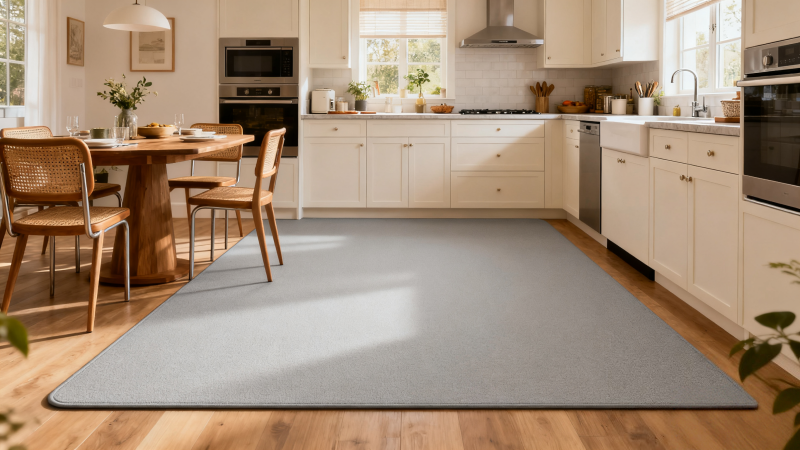
3. Structural Design: Balancing Function and Aesthetics
Differences in kitchen rug construction directly affect the user experience. Some rugs adopt a thick pile design, with strong water absorption capacity, which can quickly absorb water on the ground and keep it dry; there are also thin rugs that fit stylish kitchens with their simple and neat structure, do not take up too much space, and can highlight the texture of the floor itself.
In addition, most practical rugs are equipped with anti-slip backs (such as rubber backs) to enhance adhesion to the ground, prevent displacement and slipping, and add protection to kitchen safety. The choice of structure needs to be comprehensively judged based on factors such as family foot traffic and cleaning habits.
Materials and Construction of Kitchen Rugs: Core Considerations for Safety and Practicality
1. Material Selection: Adapting to Kitchen Scene Needs
Kitchen rug materials need to balance durability and practicality. Soft cotton rugs have a gentle touch, suitable for creating a warm atmosphere, but require timely cleaning to prevent moisture absorption; bamboo rugs are hard, wear-resistant, can withstand frequent stepping, and are waterproof and easy to maintain, fitting modern minimalist kitchens.
Quick-drying synthetic fiber (such as polyester) rugs, with their quick-drying feature, effectively avoid water residue, especially suitable for wet-prone areas like around the sink, meeting needs in different usage scenarios.
2. Structural Design: Balancing Function and Aesthetics
Differences in kitchen rug construction directly affect the user experience. Some rugs adopt a thick pile design, with strong water absorption capacity, which can quickly absorb water on the ground and keep it dry; there are also thin rugs that fit stylish kitchens with their simple and neat structure, do not take up too much space, and can highlight the texture of the floor itself.
In addition, most practical rugs are equipped with anti-slip backs (such as rubber backs) to enhance adhesion to the ground, prevent displacement and slipping, and add protection to kitchen safety. The choice of structure needs to be comprehensively judged based on factors such as family foot traffic and cleaning habits.
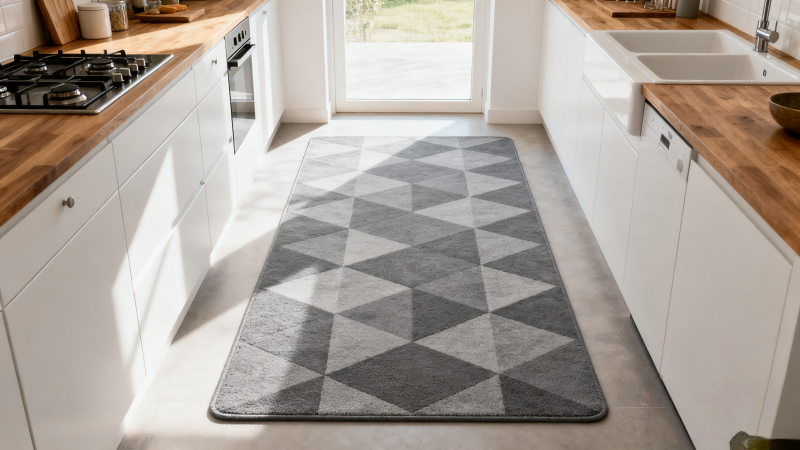
Safety Features of Kitchen Rugs: Key Designs for Protecting Cooking Spaces
1. Physical Anti-Slip Design: Building the First Line of Defense Against Falling
Kitchen floors easily become slippery due to water stains and oil stains, so the anti-slip design of rugs is particularly crucial. Most safe rugs use rubber or PVC anti-slip backs, which enhance adhesion to the floor through dense anti-slip particles to prevent rug displacement.
Some rugs also have textured structures such as raised lines and checks on their surfaces to further improve friction between feet and the rug. Even if shoe soles are wet, they can effectively prevent slipping, reducing the risk of falling from a physical perspective and ensuring safety during daily walking and meal preparation.
2. Water-Absorbent and Stain-Resistant Materials: Maintaining a Dry and Clean Floor
Water absorption is an important safety highlight of kitchen rugs. Rugs made of cotton, microfiber and other materials can quickly absorb spilled water and soup, preventing water accumulation on the floor; at the same time, these materials can also absorb small food crumbs, reducing foot slipping caused by crumbs or accumulation of floor stains.
By locking in moisture and dirt in a timely manner, the rug can maintain a dry and clean floor for a long time, providing a secure environment for kitchen activities and making cooking and walking more reassuring.
Kitchen Rugs: A Comprehensive Guide from Selection to Decoration
1. Styles & Designs: Matching Diverse Kitchen Aesthetics
Kitchen rugs range in style from traditional to modern, with a wide variety of designs—geometric patterns add vitality to the space, while subtle textures create a low-key texture, catering to different decoration preferences. In terms of color, gray and white look simple and clean, while navy and ivory fit retro or warm styles, easily integrating into the color system of cabinets and countertops.
Besides, rug thickness also varies: thick plush styles are soft to the touch, ideal for enhancing comfort; minimalist thin styles are neat and do not obscure the floor’s texture, adding layers to the kitchen’s aesthetics.
2. Scientific Selection: Meeting Practical Usage Needs
Choosing a kitchen rug requires comprehensive consideration of multiple dimensions: size and shape should match the kitchen layout, such as strip-shaped rugs for narrow spaces and square ones for work areas; materials should fit the usage scenario—wear-resistant bamboo or synthetic fibers for high-foot-traffic areas, and quick-drying materials around the sink.
Meanwhile, it’s necessary to align with the kitchen’s overall color scheme and texture to ensure the rug integrates into the space and plays a decorative role. Additionally, reading user reviews and checking product descriptions (e.g., anti-slip properties, cleaning difficulty) helps avoid pitfalls and make a more suitable choice.
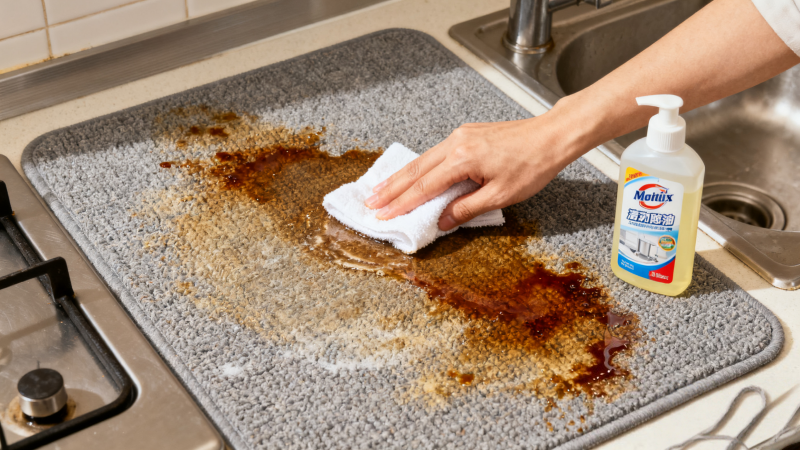
3. Popular Types & Materials: Balancing Function & Preference
Popular kitchen rug types on the market each have advantages: indoor/outdoor rugs are waterproof and sun-resistant, suitable for open kitchens or areas near windows; bathroom-style rugs have strong water absorption and anti-slip properties, ideal for wet-prone areas under the sink; entryway-style rugs are wear-resistant and stain-resistant, blocking external dust from entering the kitchen.
In terms of materials, cotton rugs are soft and skin-friendly, bamboo rugs are durable and easy to clean, and synthetic fiber rugs combine quick-drying and anti-slip features. Homeowners can choose the most suitable type and material based on their needs for comfort and durability.
4.Daily Maintenance: Extending Lifespan & Ensuring Hygiene
Regular maintenance is essential to extend the lifespan of kitchen rugs. Daily vacuuming removes food crumbs and dust, preventing accumulation and bacterial growth; for local stains, use a mild detergent for spot cleaning to avoid stain penetration.
Cleaning methods must follow material characteristics—some cotton or synthetic fiber rugs are machine washable, while bamboo or thick plush rugs require dry cleaning or hand washing to avoid deformation. Proper care not only keeps the rug clean but also prevents mold and mildew growth, ensuring kitchen hygiene.
5. Core Benefits: Enhancing Kitchen Practicality & Aesthetics
The benefits of kitchen rugs go far beyond decoration: when standing to prepare meals, soft rugs relieve foot fatigue and enhance comfort; anti-slip designs and water-absorbent materials reduce the risk of slipping, ensuring safety; meanwhile, rugs absorb noise from kitchenware collisions, making the kitchen quieter, and protect the floor from scratches.
Additionally, a style-matching rug injects warmth and texture into monotonous tiles or wooden floors, even defining functional areas (e.g., cooking area, dining nook), turning the kitchen into a space that combines practicality and personal style.
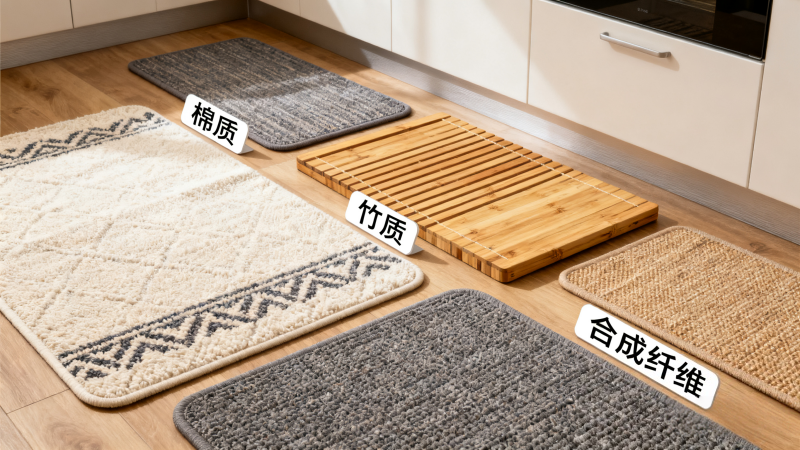
Kitchen Rugs: The Key Finishing Touch to Create an Ideal Kitchen Space
1. Core Value: The Triple Integration of Function, Aesthetics, and Safety
Kitchen rugs are by no means just decorative items, but core elements that connect the “practicality-aesthetics-safety” of the kitchen. With anti-slip backing and water-absorbent materials, they eliminate safety hazards caused by slippery floors and oil stains.
Their soft texture relieves foot fatigue from long hours of meal preparation, enhancing comfort; at the same time, with rich colors and textures, they add warmth to monotonous tiles or wooden floors, upgrading the kitchen from an “operation space” to a family core area that combines functionality and beauty.
2. Selection Key: Multi-Dimensional Considerations for Personalized Needs
Choosing an ideal kitchen rug requires comprehensive judgment based on five dimensions: “material-structure-safety-style-maintenance”. Materials should match the usage scenario (e.g., quick-drying fibers around the sink, wear-resistant bamboo for high-foot-traffic areas); structure should balance needs (thick plush for comfort, thin styles for minimalism).
Safety features should prioritize anti-slip and stain resistance; style should fit the kitchen’s overall color scheme and decoration; maintenance convenience determines long-term use costs—only with comprehensive consideration can you select a product that truly meets your needs.
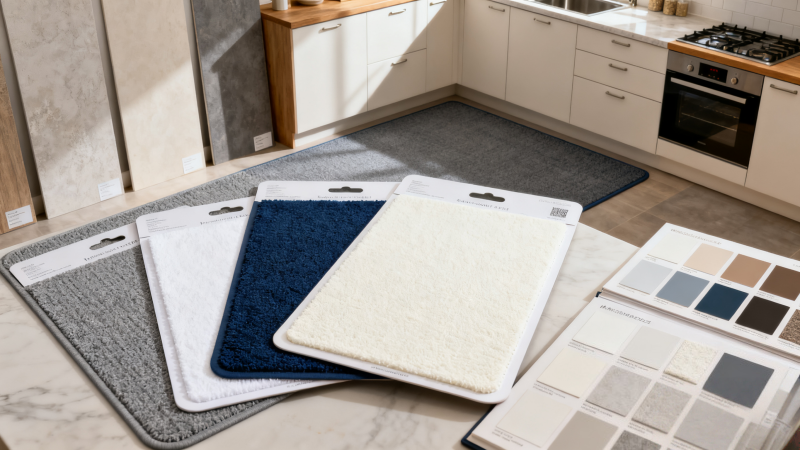
3. Aesthetic Empowerment: A Flexible Element to Enhance Space Texture
Kitchen rugs are “flexible tools” to enhance the aesthetic level of the space. Light-colored solid rugs fit the freshness of Nordic-style kitchens, checkered or printed styles echo the elegance of retro styles, and geometric patterns inject vitality into modern kitchens.
Even rugs of the same color can create a texture contrast with cabinets and countertops through texture differences (e.g., fine fluff vs. neat plain weave), avoiding monotonous spaces. A well-chosen rug makes the overall vision of the kitchen more coherent and personalized.
4. Diverse Adaptability: Rich Options Covering All Scenarios and Budgets
Whether your need is a “fashionable style”, a “cost-effective durable style”, or a “quick-drying style dedicated to the sink area”, kitchen rugs on the market can provide suitable options. Those on a budget can choose affordable synthetic fiber styles.
Those pursuing texture can select cotton-linen or bamboo products, and those focusing on convenience can choose machine-washable styles—the rich categories completely solve the problem of “disconnection between needs and choices”, ensuring users with different budgets and style preferences can find their favorite products.
5. Long-Term Value: Scientific Maintenance Extends Practical Lifespan
The value of high-quality kitchen rugs lies not only in “being easy to use now” but also in “being durable in the long run”. Regular vacuuming to remove crumbs, spot cleaning to treat stains, and choosing machine washing or dry cleaning according to the material can not only prevent the growth of bacteria and mold, ensuring kitchen hygiene, but also avoid rug deformation and fading, extending its service life.
Scientific maintenance keeps the rug in the best condition, continuously providing double protection of safety, aesthetics and comfort for the kitchen.
If you are selecting a suitable rug for your kitchen, whether you focus on material durability, style coordination or cleaning convenience, feel free to send us an inquiry at any time.https://creatprinting.com/products/
We will recommend cost-effective and high-quality exclusive options based on your specific needs!





